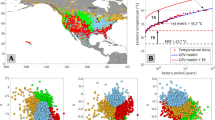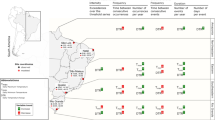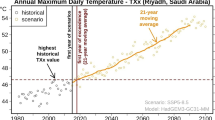Abstract
Given current international efforts to reduce greenhouse gas emissions and limit human-induced global-mean near-surface temperature increases to 2°C, relative to the pre-industrial era, we seek to determine the impact such a temperature increase might have upon the frequency of seasonal-mean temperature extremes; further we seek to determine what global-mean temperature increase would prevent extreme temperature values from becoming the norm. Results indicate that given a 2°C global mean temperature increase it is expected that for 70–80% of the land surface maximum seasonal-mean temperatures will exceed historical extremes (as determined from the 95th percentile threshold value over the second half of the 20th Century) in at least half of all years, i.e. the current historical extreme values will effectively become the norm. Many regions of the globe—including much of Africa, the southeastern and central portions of Asia, Indonesia, and the Amazon—will reach this point given the “committed” future global-mean temperature increase of 0.6°C (1.4°C relative to the pre-industrial era) and 50% of the land surface will reach it given a future global-mean temperature increase of between 0.8 and 0.95°C (1.6–1.75°C relative to the pre-industrial era). These results suggest substantial fractions of the globe could experience seasonal-mean temperature extremes with high regularity, even if the global-mean temperature increase remains below the 2°C target.



Similar content being viewed by others
References
Amstrup SC et al (2010) Greenhouse gas mitigation can reduce sea-ice loss and increase polar bear persistence. Nature 468:955–958
Anderson BT (2011) Intensification of seasonal extremes given a 2°C global warming target. Climatic Change (accepted)
Battisti DS, Naylor RL (2009) Historical warnings of future food insecurity with unprecedented seasonal heat. Science 323:240–244
Bauser CM et al (2009) Bayesian multi-model projection of climate: bias assumptions and interannual variability. Clim Dyn 33:849–868
Ben Ari T et al (2008) Human plague in the USA: the importance of regional and local climate. Biol Lett 4:737–740
Betts RA et al (2011) When could global warming reach 4 degrees C? Phil Trans Roy Soc 369:67–84
Clark RT, Murphy JM, Brown SJ (2010) Do global warming targets limit heatwave risk? Geophys Res Lett 37:L17703
Council of the European Union (2005) Presidency conclusions–Brussels 22 and 23 March 2005
Diffenbaugh NS, Ashfaq M (2010) Intensification of hot extremes in the United States. Geophys Res Lett 37. doi:101029/2010GL043888
Diffenbaugh NS, Scherer M (2011) Observational and model evidence of global emergence of permanent, unprecedented heat in the 20th and 21st centuries. Clim Chang. doi:10.1007/s10584-011-0112-y
Fan Y, van den Dool H (2008) A global monthly land surface air temperature analysis for 1948-present. J Geophys Res 113:D01103
Fung F, Lopez A, New M (2011) Water availability in +2C and +4C worlds. Phil Trans Roy Soc 369:99–116
Hoegh-Guldberg O et al (2007) Coral reefs under rapid climate change and ocean acidification. Science 318:1737–1742
Intergovernmental Panel on Climate Change (IPCC) (2007a) In: Solomon S, Qin D, Manning M, Chen Z, Marquis M, Averyt KB, Tignor M, Miller HL (eds) Climate change 2007: the physical science basis contribution of working group I to the fourth assessment report of the intergovernmental panel on climate change. Cambridge University Press, Cambridge, United Kingdom and New York, NY, USA
Intergovernmental Panel on Climate Change (IPCC) (2007b) In: Parry ML, Canziani OF, Palutikof JP, van der Linden PJ, Hanson CE (eds) Climate change 2007: impacts adaptation and vulnerability contribution of working group II to the fourth assessment report of the intergovernmental panel on climate change. Cambridge University Press, Cambridge, United Kingdom and New York, NY, USA
Kamenos NA (2010) North Atlantic summers have warmed more than winters since 1353, and the response of marine zooplankton. Proc Natl Acad Sci 107:22442–22447
Kaplan JO, New M (2006) Arctic climate change with a 2 degrees C global warming: timing, climate patterns and vegetation change. Clim Chang 79:213–241
Lobell DB, Schlenker W, Costa-Roberts J (2011) Climate trends and global crop production since 1980. Science. doi:10.1126/science.1204531
Lorenz R, Jaeger EB, Seneviratne SI (2010) Persistence of heat waves and its link to soil moisture memory. Geophys Res Lett 37. doi:10.1029/2010GL042764
May W (2008) Climatic changes associated with a global 2-degree C stabilization scenario simulated by the ECHAM5/MPI-OM coupled climate model. Clim Dyn 31:283–313
Meehl GA, Tebaldi C (2004) More intense, more frequent, and longer lasting heat waves in the 21st century. Science 305:994–997
Mitchell TD, Jones PD (2005) An improved method of constructing a database of monthly climate observations and associated high-resolution grids. Int J Clim 25:693–712
Nakićenović N et al (2000) Special report on emissions scenarios: a special report of working group III on the Intergovernmental Panel on Climate Change. Cambridge University Press, Cambridge
New M, Hulme M, Jones PD (2000) Representing twentieth century space-time climate variability. Part 2: development of 1901–96 monthly grids of terrestrial surface climate. J Clim 13:2217–2238
Sanderson MG, Hemming DL, Betts RA (2011) Regional temperature and precipitation changes under high-end (>4°C) global warming. Phil Trans Roy Soc A 369:85–98
Schlenker W, Roberts MJ (2006) Nonlinear effects of weather on corn yields. Rev Agr Econ 28:391–398
Seneviratne SI et al (2006) Land-atmosphere coupling and climate change in Europe. Nature 443:205–209
Sherwood SC, Huber M (2010) An adaptability limit to climate change due to heat stress. Proc Natl Acad Sci 107:9552–9555
Smith JB et al (2009) Assessing dangerous climate change though an update on the International Panel on Climate Change (IPCC) “reasons for concern”. Proc Natl Acad Sci U S A 106:4133–4137
Stenseth NC et al (2002) Ecological effects of climate fluctuations. Science 297:1292–1296
United Nations Framework Convention on Climate Change (UNFCCC) (2009) The Copenhagen accord 5 pp U N Geneva Switzerland
Woollings T (2010) Dynamical influences on European climate: an uncertain future. Phil Trans Roy Soc A 368:3733–3756
Xu JC et al (2009) The melting Himalayas: cascading effects of climate change on water, biodiversity, and livelihoods. Conservat Biol 23:520–530
Zelazowski P et al (2011) Changes in the potential distribution of humid tropical forests on a warmer planet. Phil Trans Roy Soc 369:137–160
Further reading
Ballester J, Rodo X, Giorgi F (2010) Future changes in Central Europe heat waves expected to mostly follow summer mean warming. Clim Dyn 35:1191–1205
Ebisuzaki W (1997) A method to estimate the statistical significance of a correlation when the data are serially correlated. J Clim 9:2147–2153
Mitchell TD (2003) Pattern scaling: an examination of the accuracy of the technique for describing future climates. Clim Chang 60:217–242
Wang H et al (2009) Attribution of the seasonality and regionality in climate trends over the United States during 1950–2000. J Clim 22:2571–2590
Acknowledgements
We first thank the anonymous reviewers their insightful comments on the manuscript. We also acknowledge the modeling groups, the Program for Climate Model Diagnosis and Intercomparison (PCMDI) and the WCRP’s Working Group on Coupled Modeling (WGCM) for their roles in making available the WCRP CMIP3 multi-model dataset. Support of this dataset is provided by the Office of Science, U.S. Department of Energy. University of East Anglia Climate Research Unit (CRU) temperature data made available by the British Atmospheric Data Centre, 2008. Available from http://badc.nerc.ac.uk/data/cru
Author information
Authors and Affiliations
Corresponding author
Electronic supplementary material
Below is the link to the electronic supplementary material.
ESM 1
(DOC 36 kb)
Rights and permissions
About this article
Cite this article
Anderson, B.T. Near-term increase in frequency of seasonal temperature extremes prior to the 2°C global warming target. Climatic Change 108, 581–589 (2011). https://doi.org/10.1007/s10584-011-0196-4
Received:
Accepted:
Published:
Issue Date:
DOI: https://doi.org/10.1007/s10584-011-0196-4




